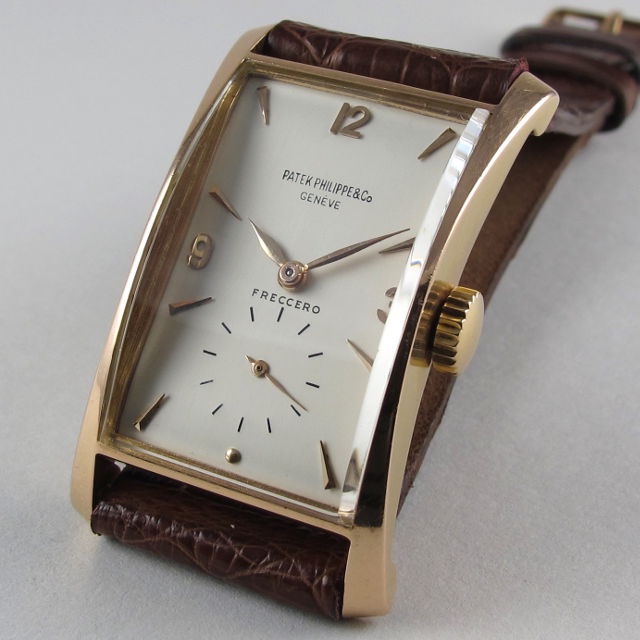
The Patek Philippe shaped calibers

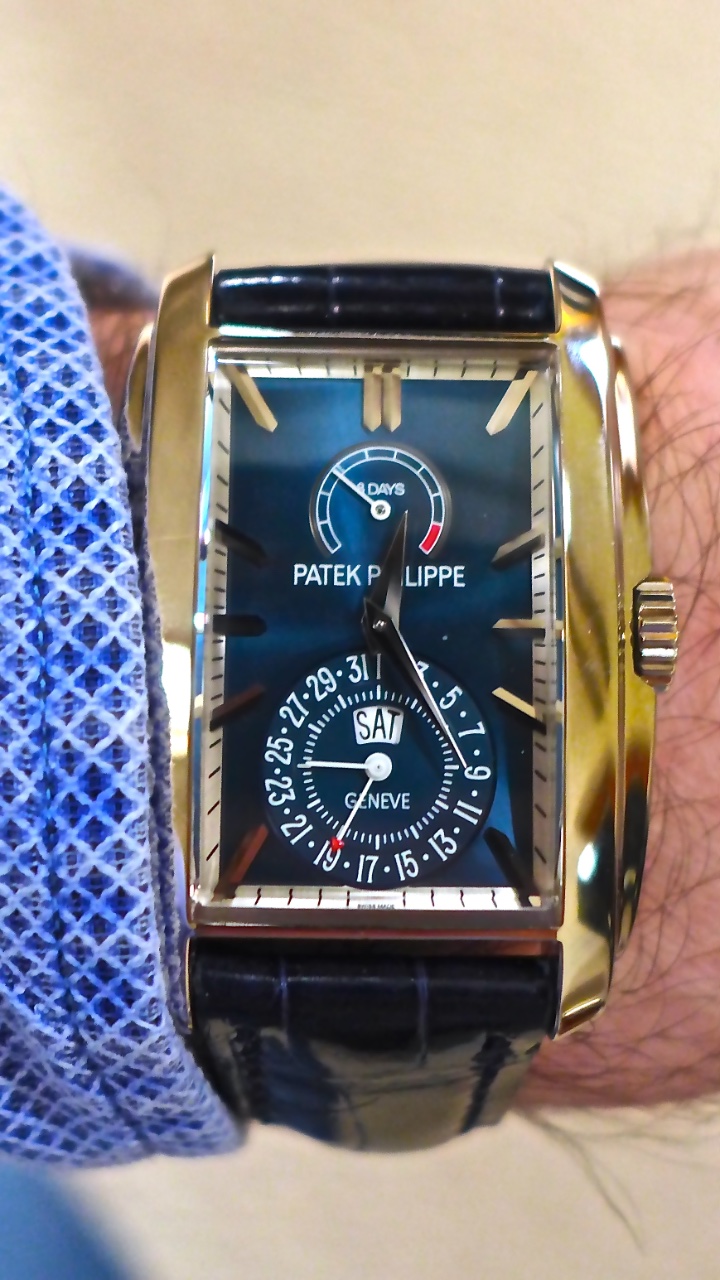
Though I have been a member for several years, I don’t contribute much to the Forum.
This article was in the making for several months. I shared the French draft version with Mark some months ago and he encouraged me to publish it on the Purists.
I am a strong believer that shaped watches i.e. non-round watches, especially rectangular and « tonneau » ones, should be fitted with calibers of the same vein. The production of shaped calibers aka non-round movements caught my attention and I started digging into my library. This contribution is a synthesis from various sources and is not exhaustive.
The shaped calibers can be distinguished in two categories:
- The time when Patek Philippe wristwatches were fitted with ebauche calibers purchased from third party suppliers;
- The period where Patek Philippe began producing its own calibers. In 1932, the Stern brothers, who just acquired the manufacture, appointed Jean Pfister as the new CEO. He decided launching the production of in house calibers for wristwatches. Patek Philippe will however continue using ebauche movements beyond 1932. This practice disappeared relatively recently with the introduction of the in house manual chronograph caliber CH 29-535 which has replaced the Lemania caliber 2310 / CH 27-70.
The third party ebauche calibers era
Listing all the third party ebauche calibers used by Patek Philippe is quite tedious because the number of references is relatively large.
The complete catalog of the Museum does not allow to accurately listing the various calibers whereas the Huber & Banbery book contains pictures of about twenty shaped ebauche calibers.

Very often, it may be either single references or watches produced in relatively small quantities. Indeed, these watches are mostly referenced based on their caliber and/or case numbers, as at that time, Patek Philippe had not yet adopted a single reference number for identifying their watches.
The shapes are diverse: rectangular, "tonneau", "baguette" and oval. The main ebauche calibers third party suppliers were LeCoultre, Klauber, Meylan, Niton and Piguet.
Among the most interesting references, there are a few that caught my attention.
The 10 lignes tonneau shape movement (references caliber Number 826574-826579 and 826580-826585) that is an ebauche caliber from LeCoultre. The watch shown below has a beautiful Art Deco style rectangular case combining rose gold and platinum.
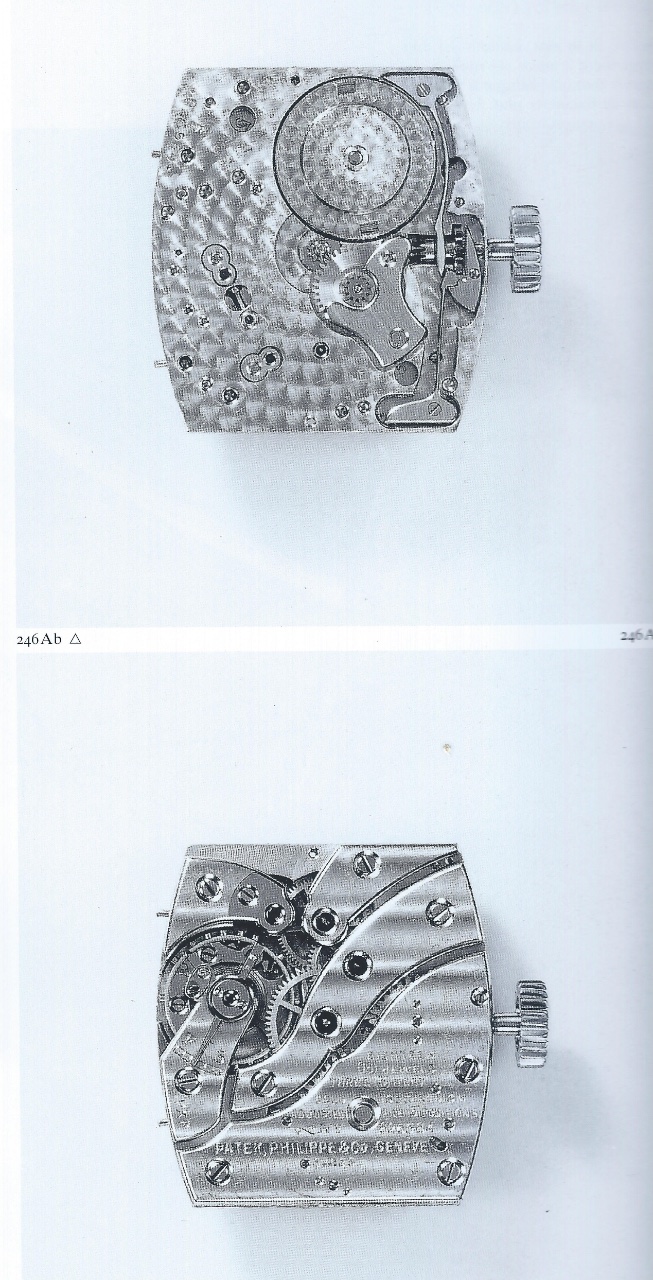
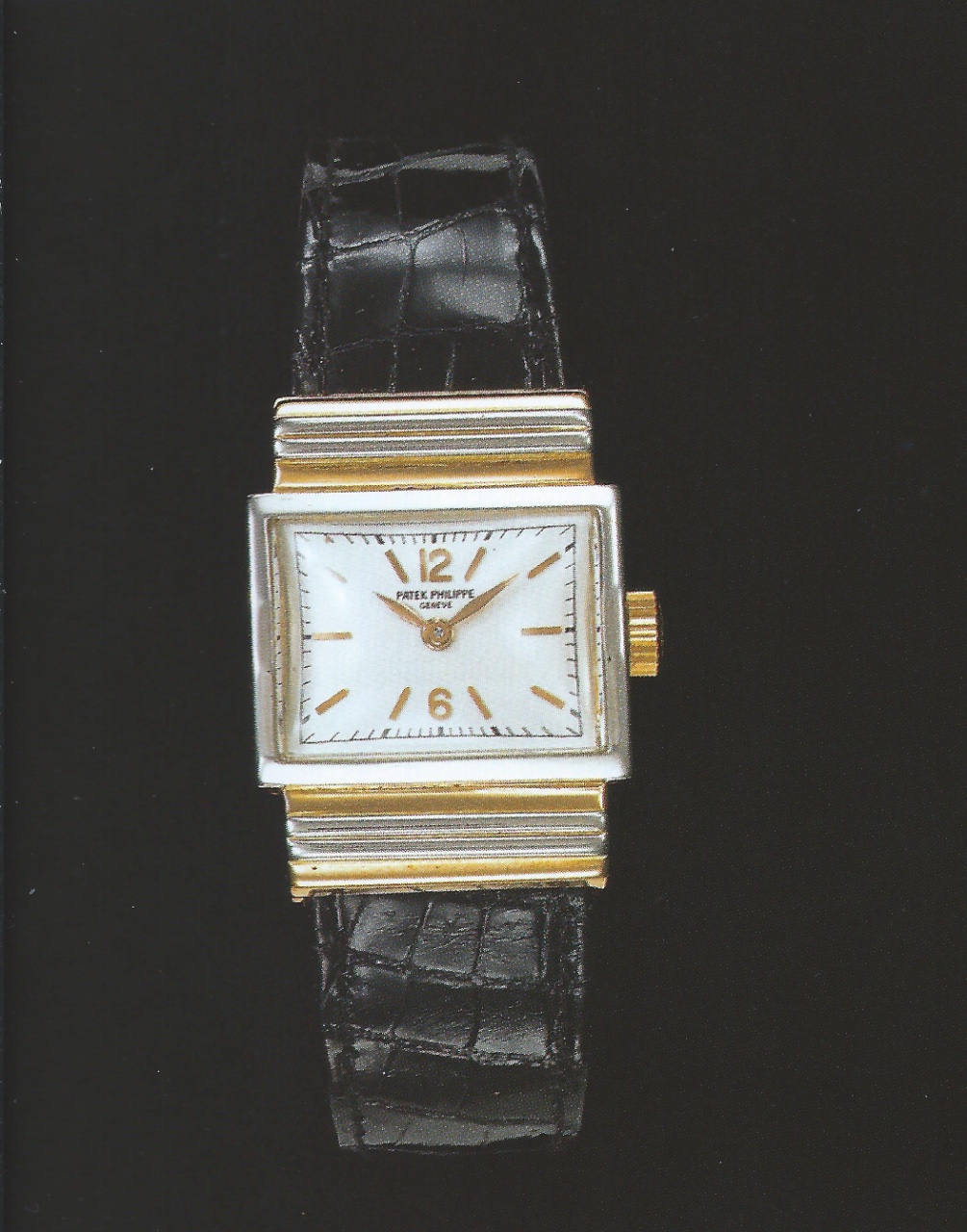
The reference model 106 "Reverso" for ladies. Between December 1931 and April 1932, eight Reverso cases were sold to Patek Philippe. This was done with the support from César de Trey, who had already registered the "Reverso" brand name as a trademark, and Jacques-David LeCoultre, then a director at Patek Philippe. This allowed Patek Philippe to issue under its own name eight Reverso watches bearing the reference number 106. Out of these 8 watches, the sole Ladies’ model is fitted with a 7 lignes rectangular ebauche movement from LeCoultre (Catalogue of the Patek Philippe Museum. - Volume 2, page 212) while the Men’s models have a round caliber.
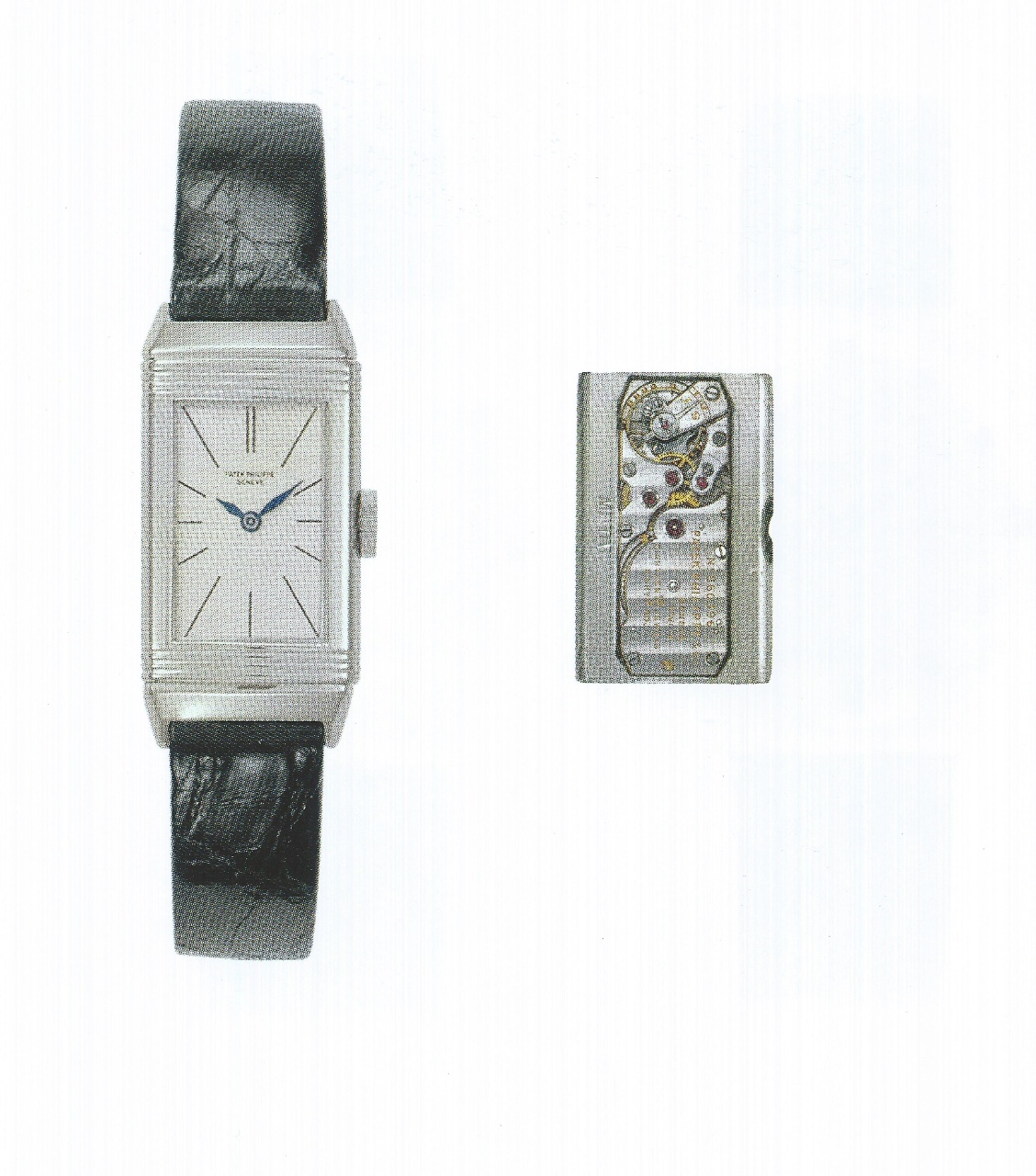
Very few shaped ebauche calibers come with complications.
Huber & Banbery and Patrizzi indicate the use of several 9 lignes ebauche calibers from LeCoultre with a twin barrel and an 8 days power reserve. This is the very same 124 LeCoultre caliber that also equips the Cartier Tank "Eight Days". This rectangular movement is fitted in an exquisite Art Deco style case. The dial proudly bears the "8 days" mention. The reference number 198443 mentioned by Patrizzi was produced in 1931 (the year of the introduction of this caliber by LeCoultre) while the reference number 198451 mentioned by Huber & Banbery was produced in 1933. Based on the caliber numbers, we can assume that there would be at least eight "8 days" watches.
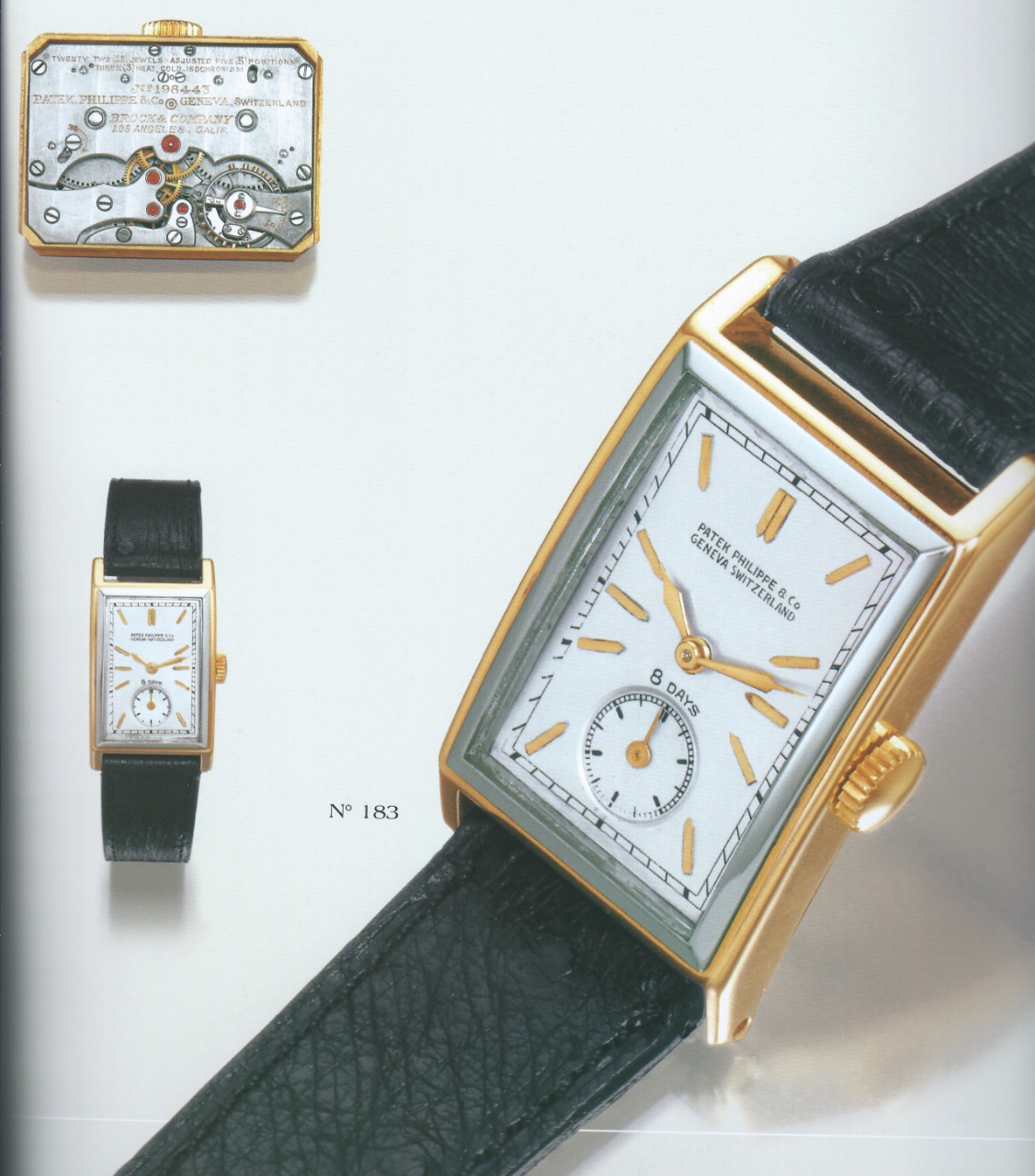
The caliber with a triple calendar and moon phase is an 11 lignes "tonneau" shape ebauche caliber from Niton. It is the sole movement with so many complications. Patek Philippe purchased a set of thirty calibers in the late 1930s. The rectangular watch comprises three apertures for the calendar indication.
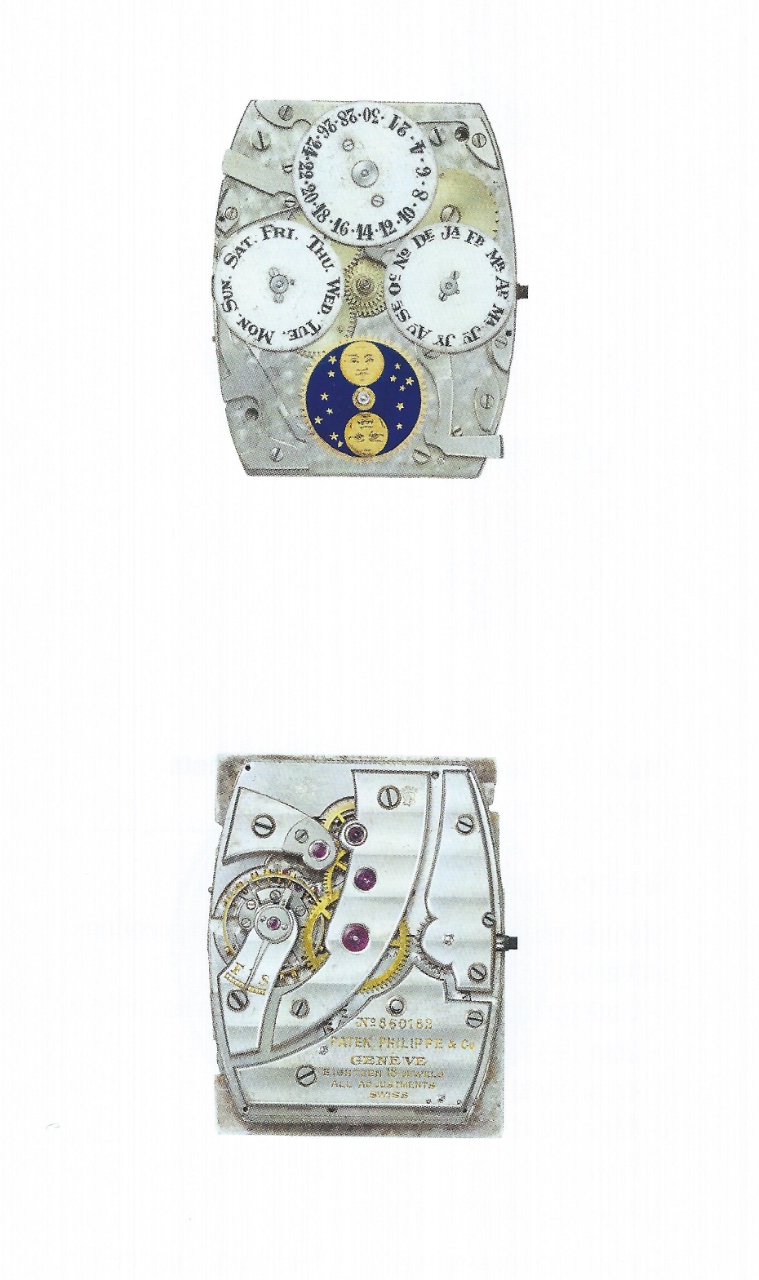
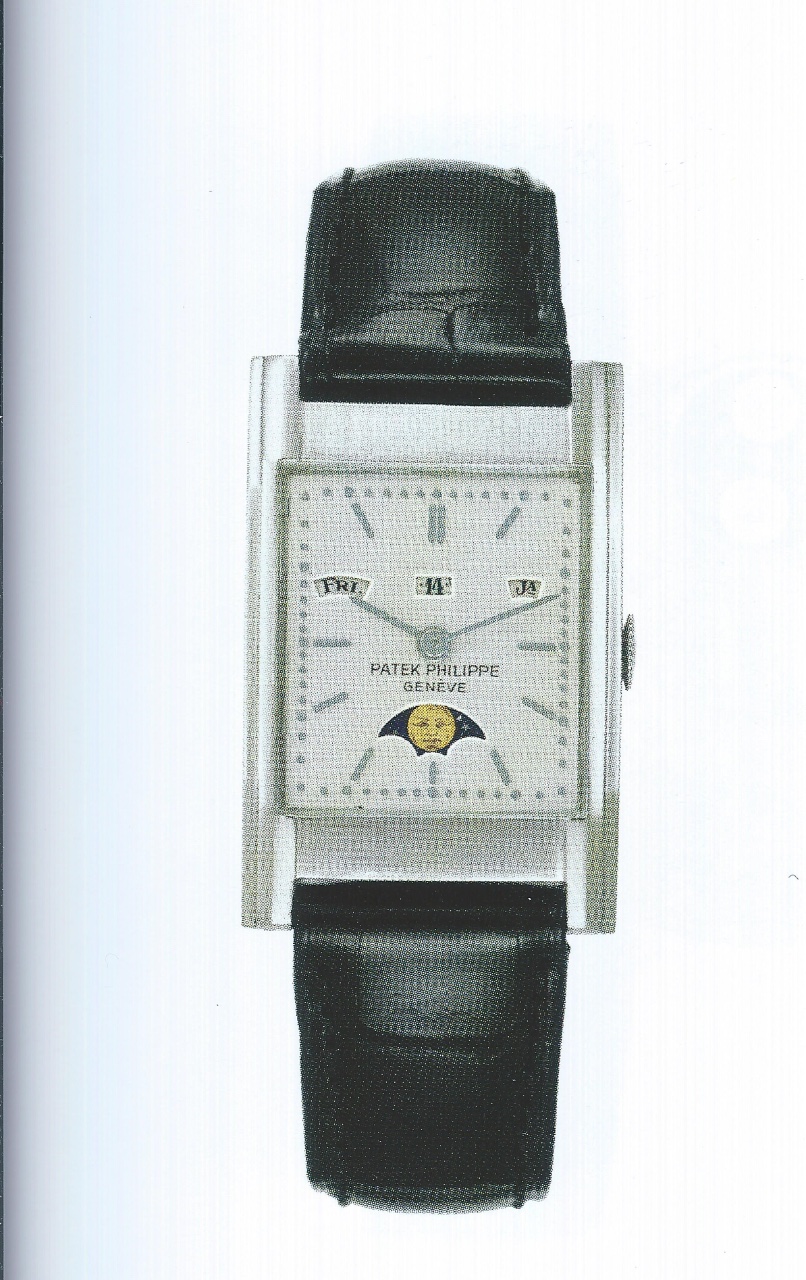
The use of shaped ebauche calibers will continue until the 1950s. For example, Patek Philippe launched in 1953, the reference 2295 pagoda shape ladies’ watch. This so called "Mistinguett" watch is fitted with an oval shape caliber. It is worth noting that its reissue in 1997 as a commemorative limited edition under the reference 4900 is equipped with a round caliber and not a shaped movement.
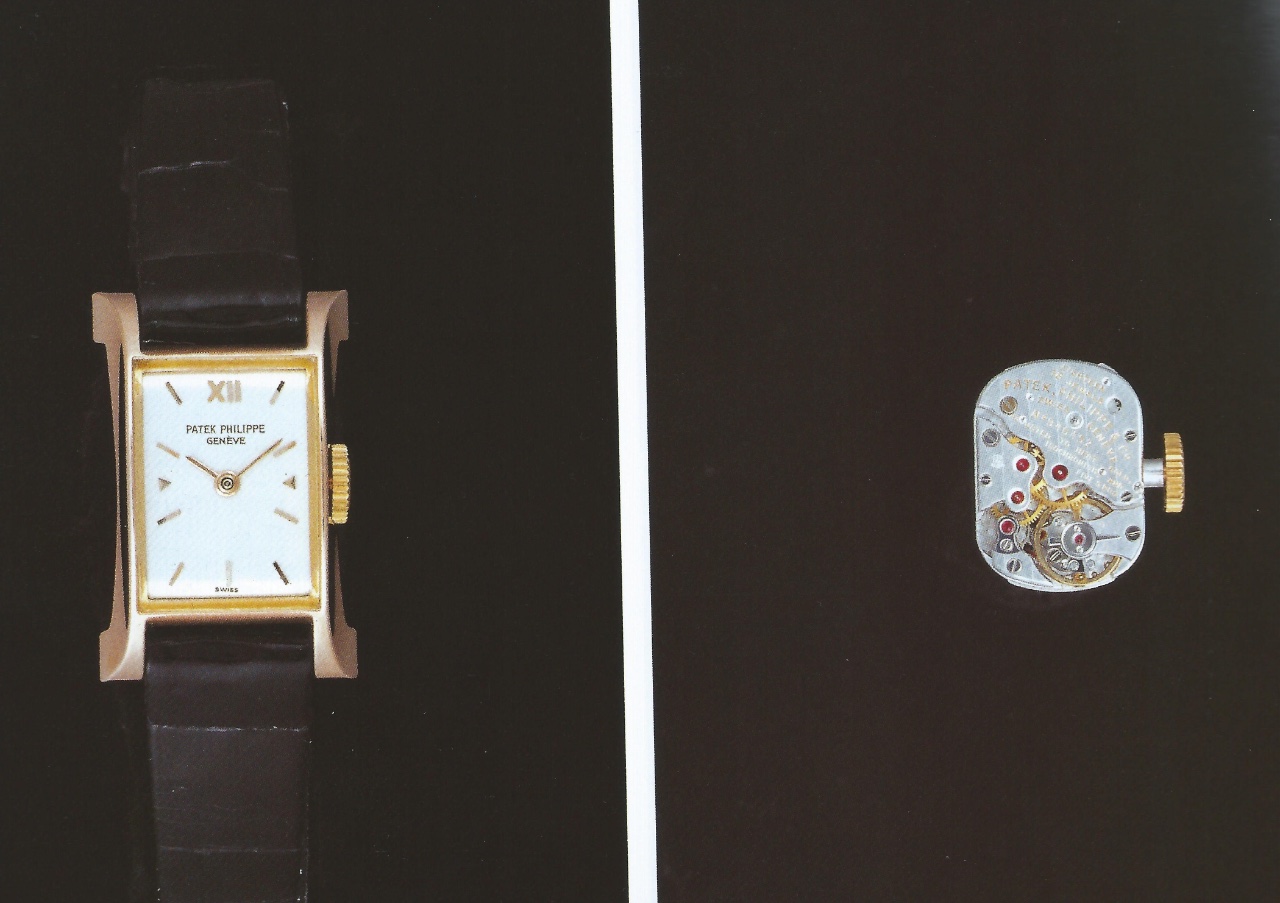
The in house production era
The number of references of in house shaped calibers is rather limited. There are five "families" of shaped calibers:
- The 9-90 calibers
- The 8-80 calibers
- The 34 calibers
- The 25-21 calibers
- The 28-20 calibers
The 9-90 calibers
The 9-90 caliber was produced from 1934 to 1967. Its dimensions are 18.00 by 25.60 mm with a thickness of 3.65 mm. It experienced some updates. The Gyromax balance was later incorporated in this caliber. Moreover, a Breguet overcoil hairspring later replaced the initial flat hairspring. This caliber beats at a frequency of 19,800 vibrations per hour.
It usually features a small second but there is also a "simple" version.
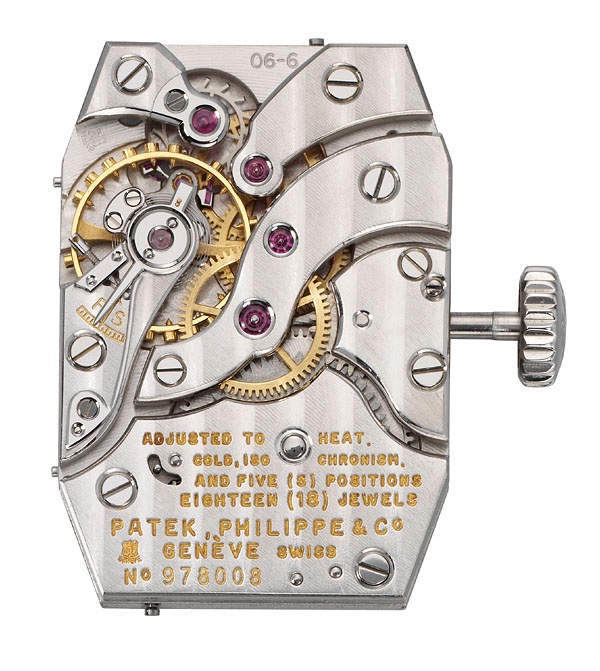
According to Huber & Banbery, the production of the 9-90 calibers spans from 1934 starting with the reference number 830000 until 1967 with the reference number 977889. Considering that there were two main production batches (reference numbers 830000-839999 from1934 to 1950 and reference numbers 970000-977889 from 1947 to 1967), 17,890 movements were produced. Presumably the number of watches incorporating this movement is inferior.
The number of models fitted with the 9-90 caliber is very high. I nevertheless retained some symbolic references. Each of these references is worth a detailed review.
- The 1593 reference "The Hour Glass"

- The 2441 reference "Eiffel Tower", which served as inspiration for the commemorative reissue of the "Pagoda" 5500 reference except that the latter is fitter with the round caliber 215 P
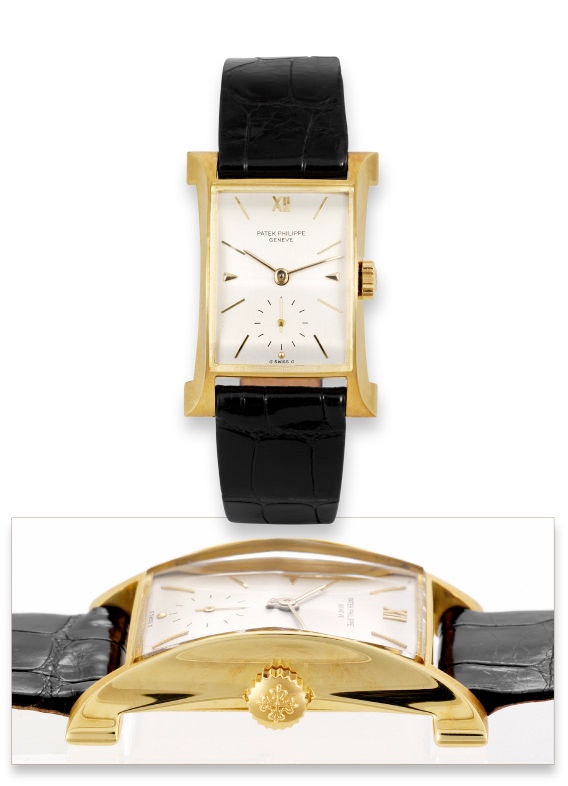
- The 2442 reference "Banana"
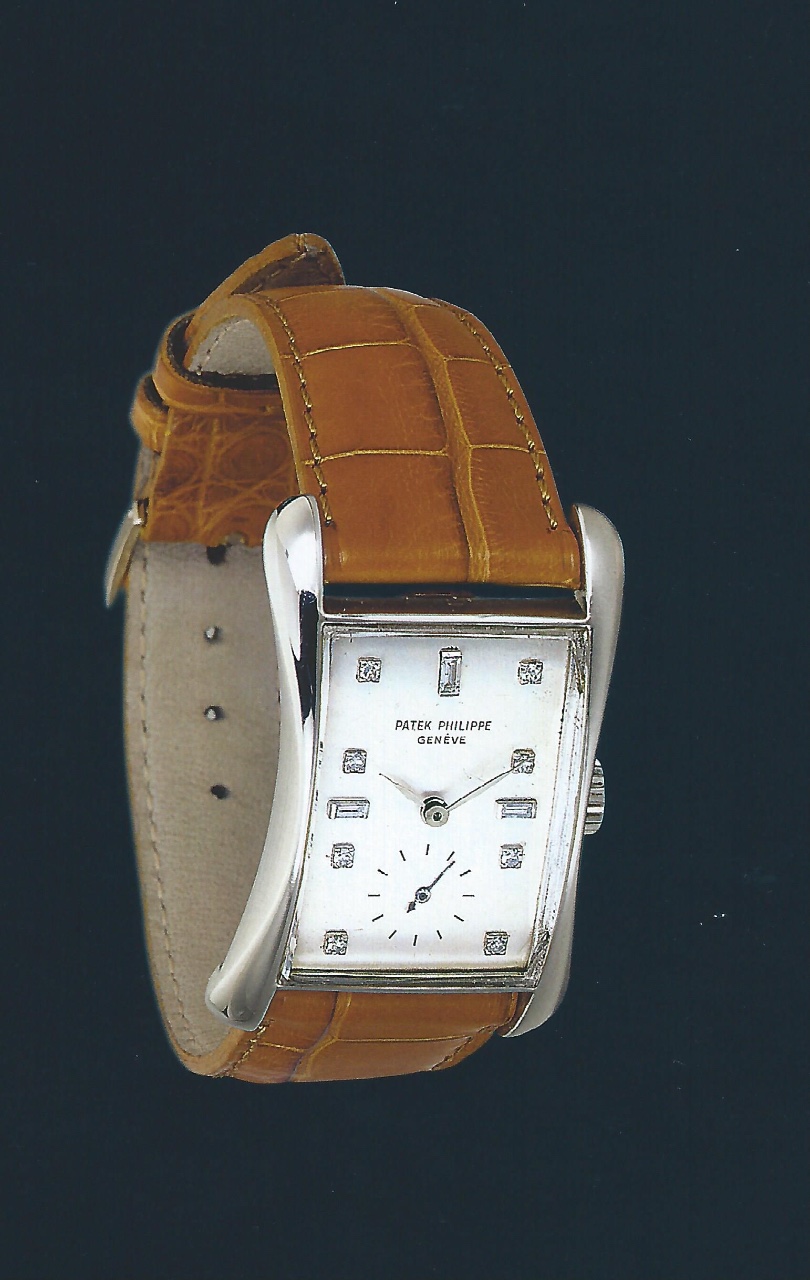
- The 2471 reference which also includes two unique specimens with cloisonné enamel dials
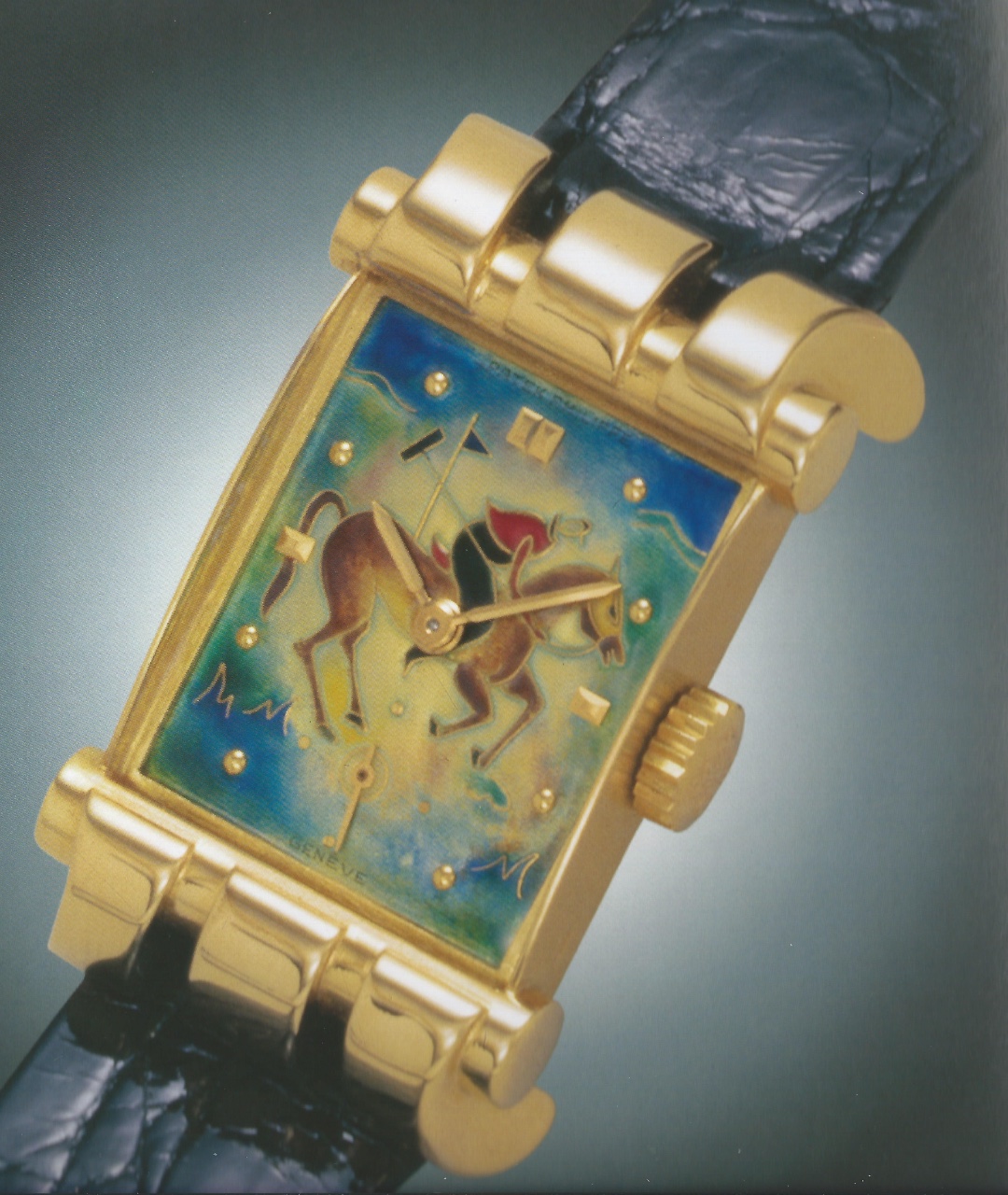
- The 2554 reference "Manta Ray" which inspired the "10 days" 5100 reference
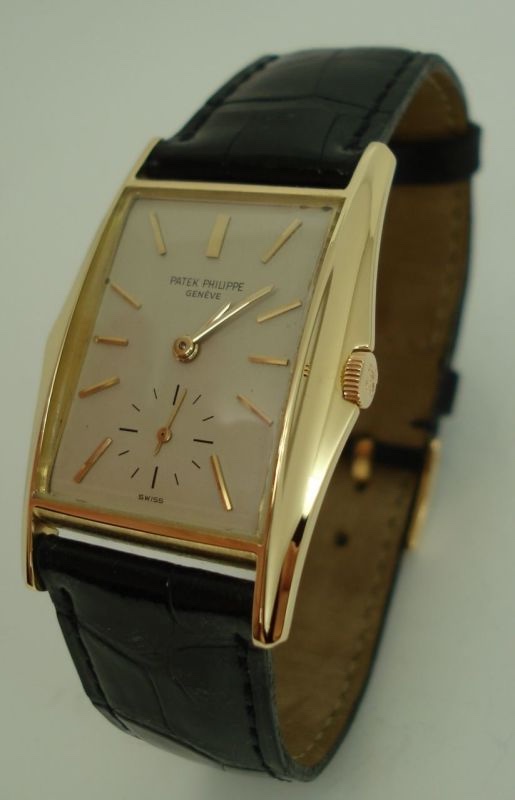
The 9-90 movement also drives the unique linear minute and hour display prototype developed by Louis Cottier and which is shown at the Patek Philippe Museum.
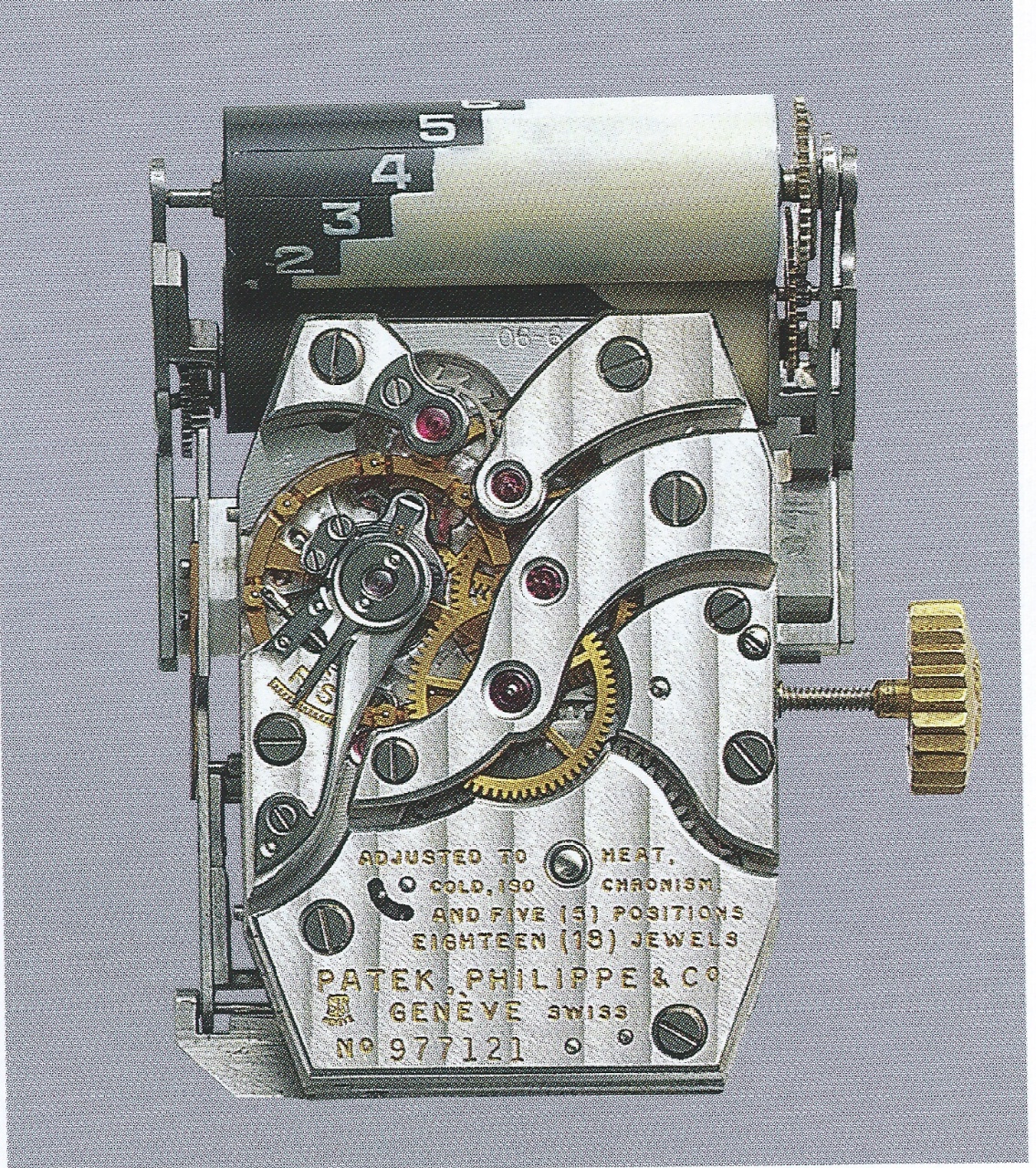
John Golberger inventoried 7 steel watches with the caliber 9-90: two references 490, one reference 492, one reference 514, one 1544 reference, one reference 1530 and one reference 522. The cases of 514, 520 and 524 with their triple tiered flanks have certainly been a source of inspiration for the 5101 reference “10 days” Tourbillon.
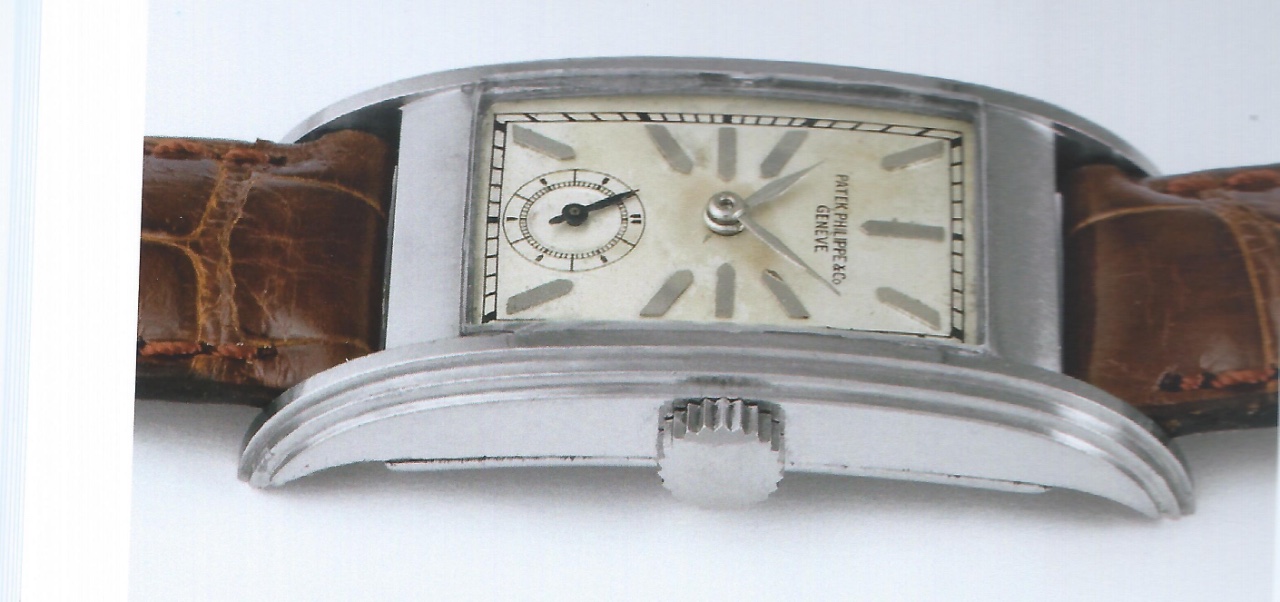
During the move in 1996 to its new headquarters in Plan-les-Ouates, Patek Philippe found a box containing one hundred 9-90 calibers. These movements were produced in 1957. They were later fitted into the 5105 reference that is a beautiful platinum Art Deco style watch issued in a limited edition celebrating the reopening in 2006 of the Patek Philippe Salons in Geneva.
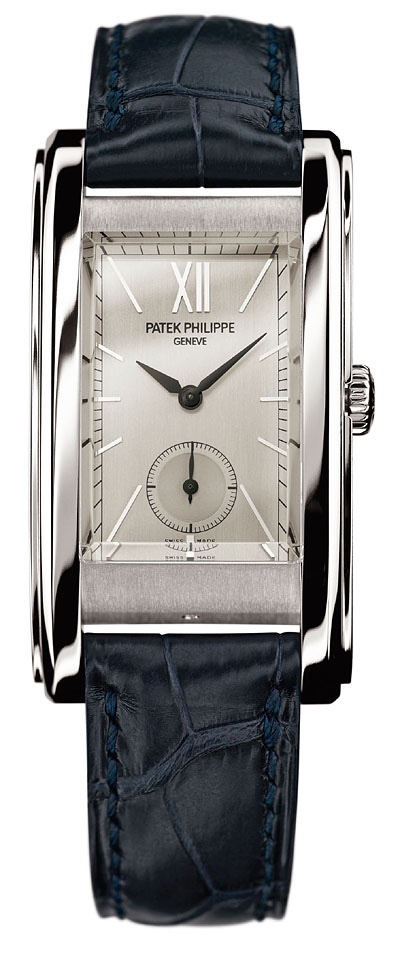
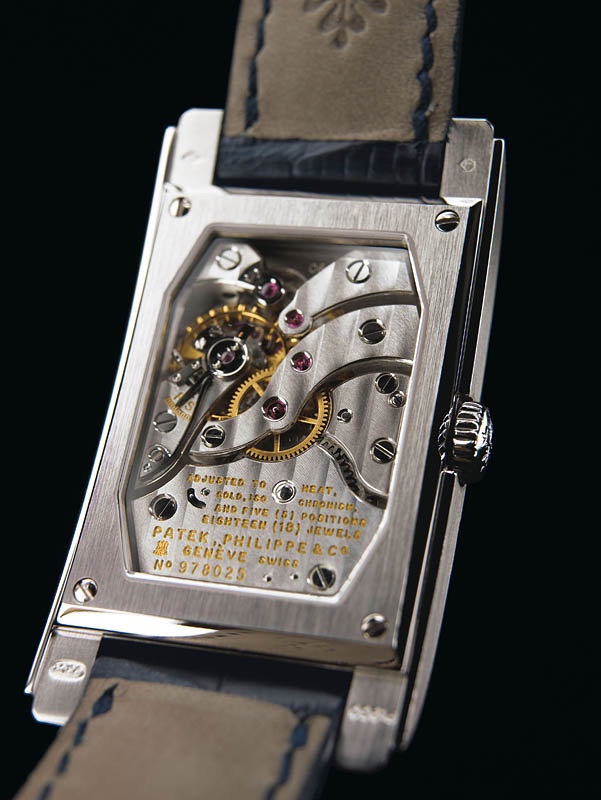
The 8-80 caliber
In 1935, Patek Philippe launched the production of the 8-80 rectangular caliber for Ladies watches. 3,918 movements will be produced and they will be used until the 1960s.
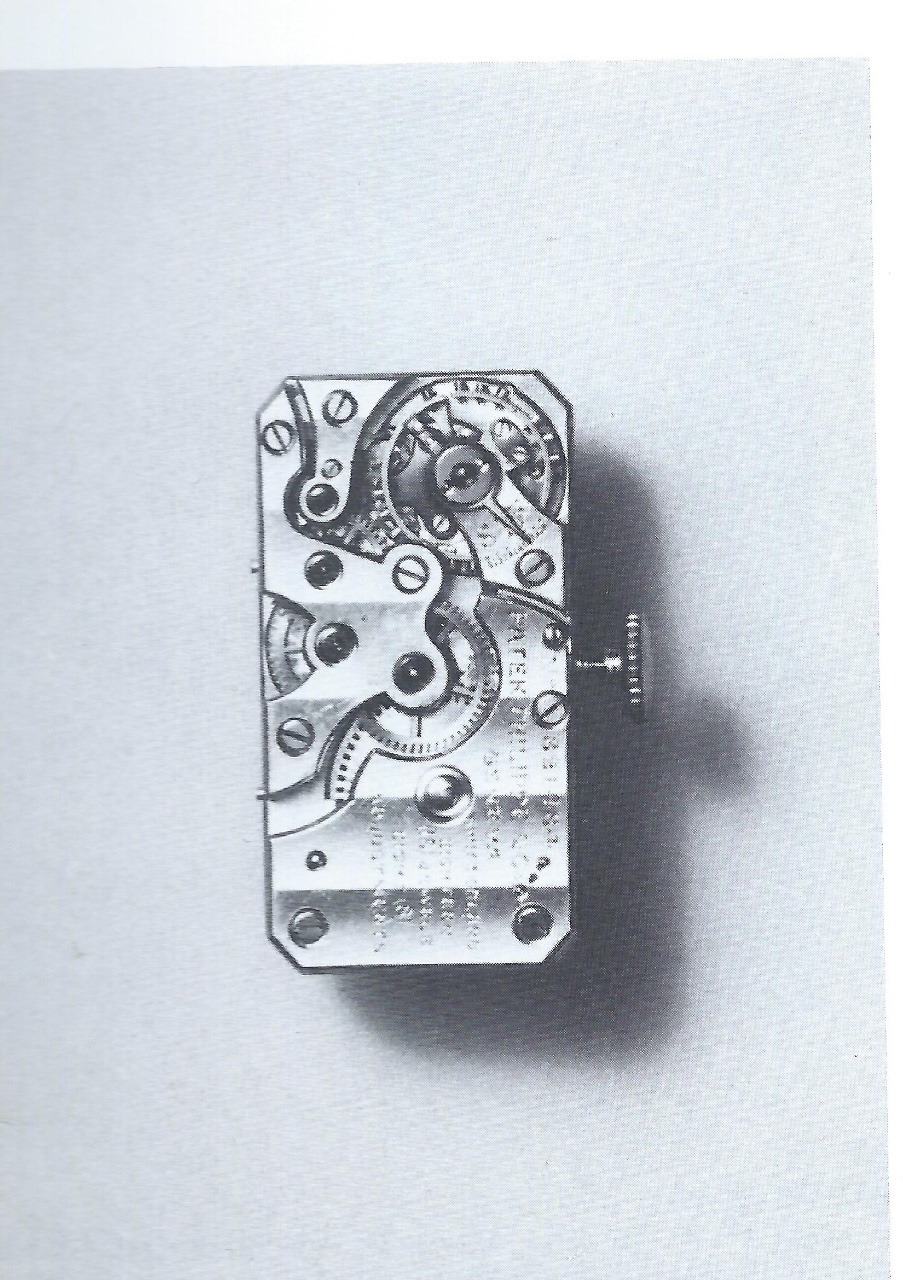
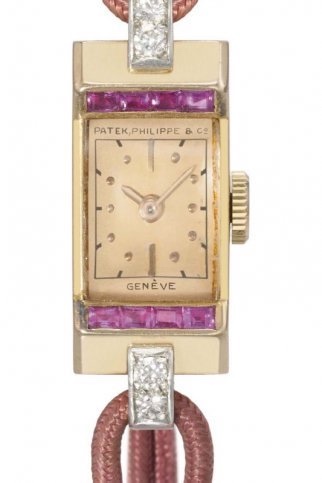
The 34 calibers
The family of the 34 calibers includes two movements: the "34S" and the "34T". These chronometer timing competition movements were never intended to be mass-produced.
The 34S caliber is an observatory movement for chronometer timing competition. It features an oversized Guillaume balance wheel. Its dimensions are 34.80 x 22.00 mm for a thickness of 6.00 mm. It has an aluminum casing and dial used for testing in the Observatory. It is a unique model bearing the reference number 861278.
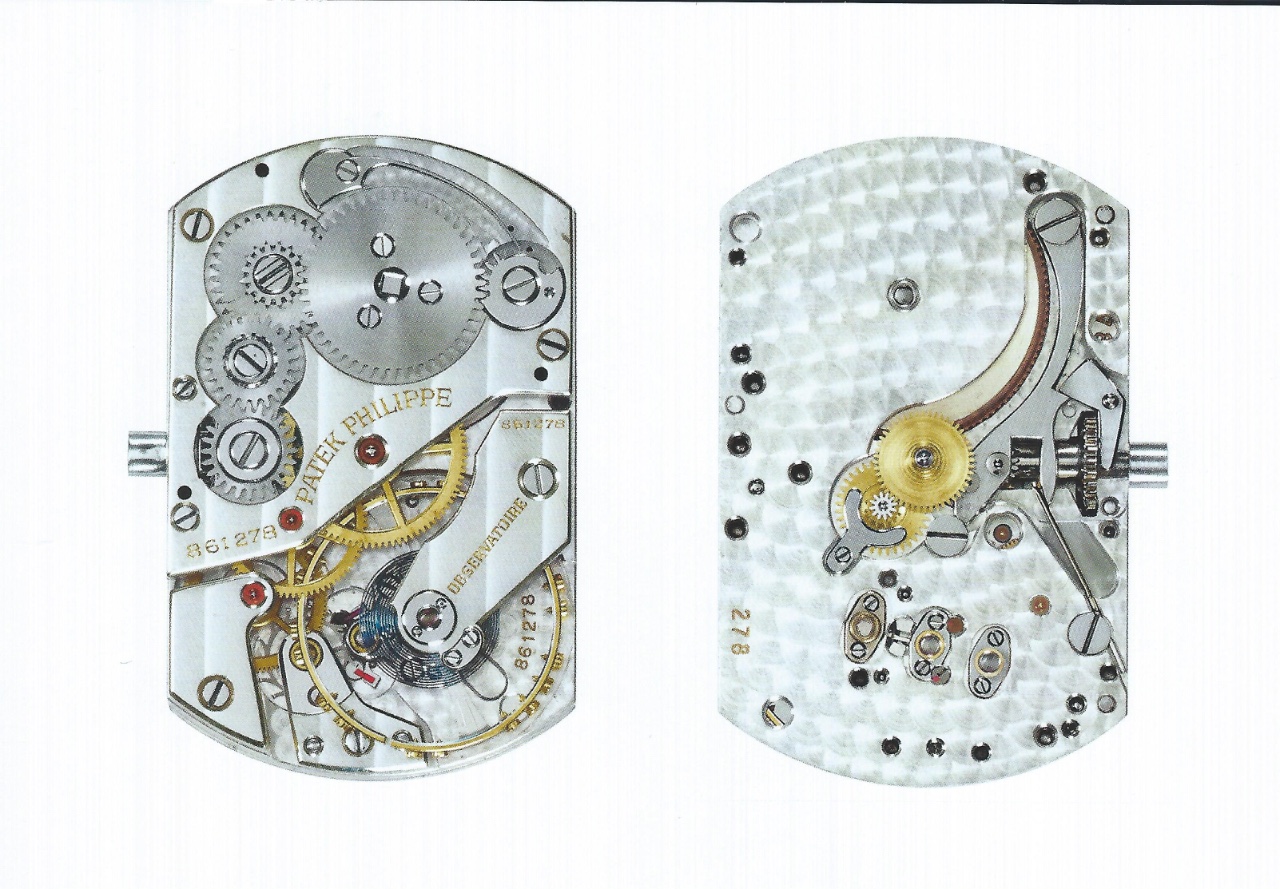
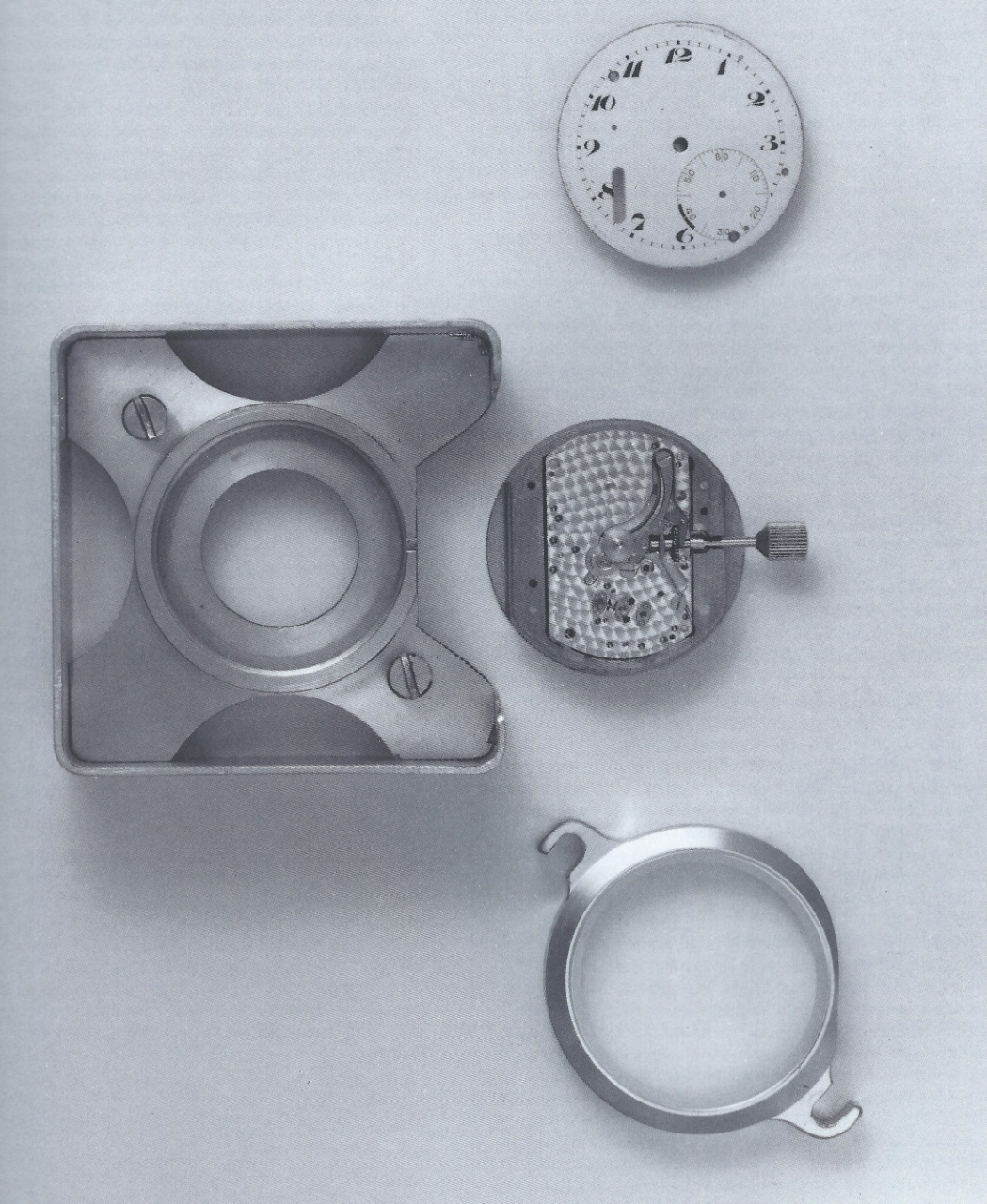
The 34T caliber is a superlative movement with a 50 seconds tourbillon, 21,600 vibrations per hour and a power reserve of 57 hours. The movement has a dimension of 34.40 by 22.20 mm. According Patrizzi and Antiquorum, five references of this caliber were produced between 1956 and 1962. The tourbillon cage is made of beryllium bronze instead of the usual polished steel.
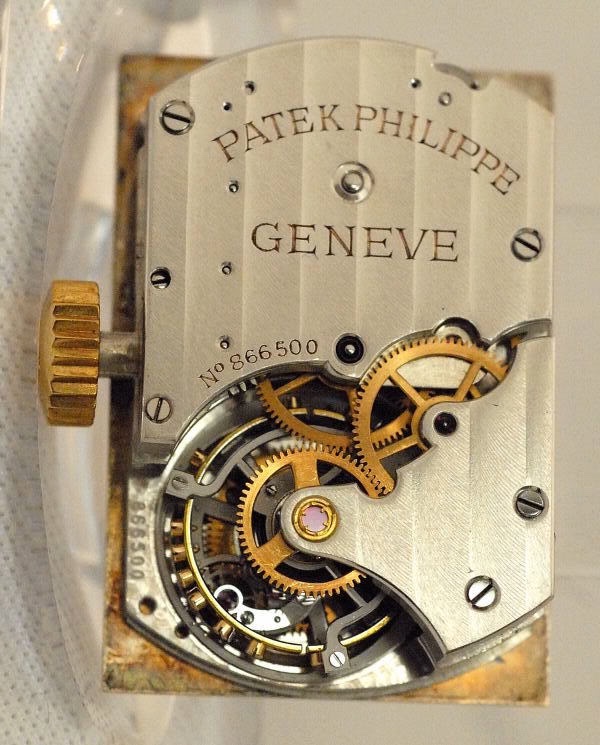
Some of these calibers were subsequently cased in the early 1980s under the reference 3834. This yellow gold case watch has fairly generous dimensions (47.70 by 29.40 mm and a thickness of 13.00 mm). The cream color dial is fitted with gold baton indexes. The auxiliary seconds dial is located between 8 and 9 hours.
One of these watches (with the movement reference number 866503) is on display at the Patek Philippe Museum. The movement was manufactured in 1956 and cased in 1983.
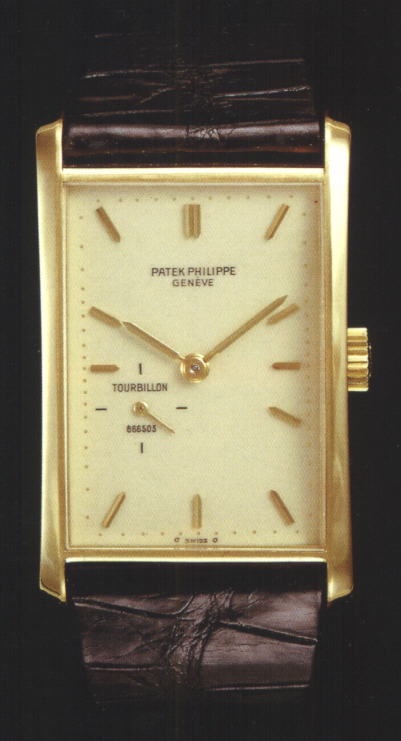
Another very same watch with the movement reference number 866502 was sold by Antiquorum during the first thematic auction that took place on April 9, 1989 to celebrate the 150 years anniversary of the factory (lot 299). This caliber was manufactured in 1960 and was cased in 1981.
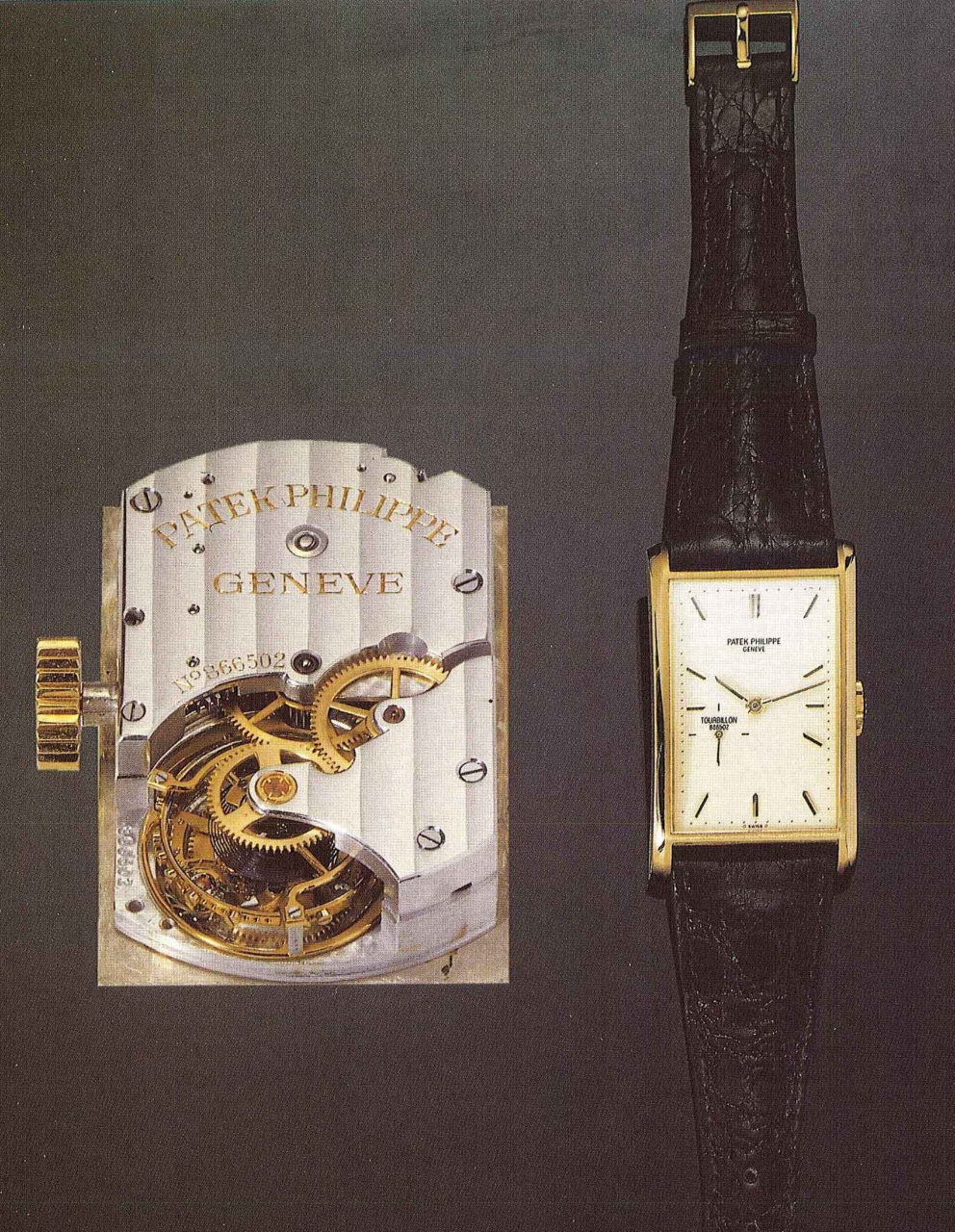
The 25-21 calibers
The 25-21 caliber is the first no complication shaped movement created by Patek Philippe since the 9-90 caliber. There is a "simple" version and a small second version. It measures 24.60 by 21.50 mm for a height of 2.57 mm. It beats at a frequency of 28,800 vibrations per hour and has a power reserve of 44 hours maximum.
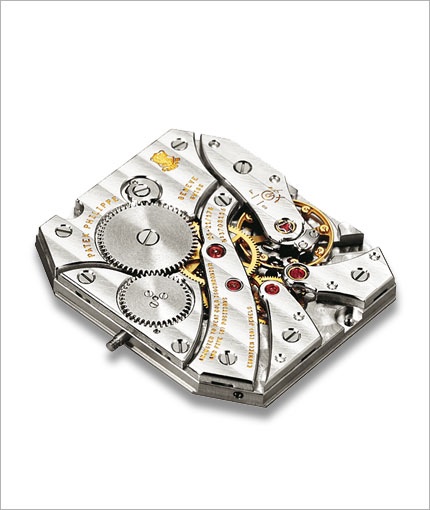
The 25-21 was introduced in 2007 with the creation of the reference 5098. A model “Chronometro Gondolo” from 1925 inspires this reference. This inspiring model was actually not fitted with a shaped but well a round caliber.
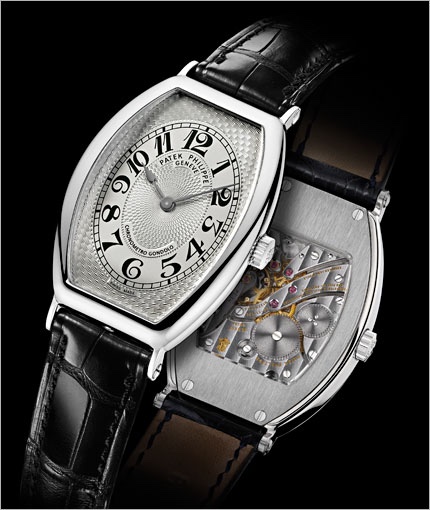
The 25-21, with its small second version, fits the reference Gondolo 5124.
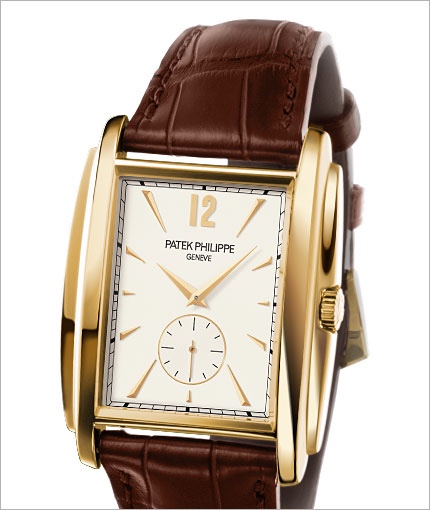
The architecture of the 25-21 is directly based on the 215 caliber with some adjustments to the bridges. It suits the "Gondolo" references very well.
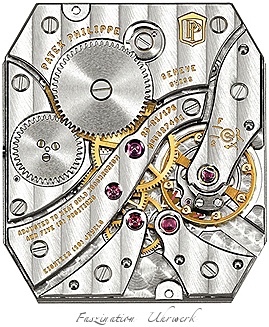
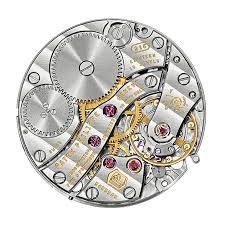
The 28-20 calibers
The 28-20 calibers family comprises three very distinct variants. Two of them can be regarded as icons of the Patek Philippe production. The three iterations are:
- 28-20 / 200 PS IRM
- 10 J 28-20 REC PS MRI
- REC 28-20 8J PS IRM C J
The 28-20 / 200 PS IRM caliber is one of the finest shaped calibers ever produced. It features a twin barrel for a 10-day power reserve. As hinted by its reference number, the caliber’s dimensions are 28.00 by 20.00 mm for a thickness of 5.05 mm. The caliber has a Gyromax balance wheel and beats at a frequency of 21,600 vibrations per hour. It takes about one hundred turns of the crown to fully wind the two barrels.
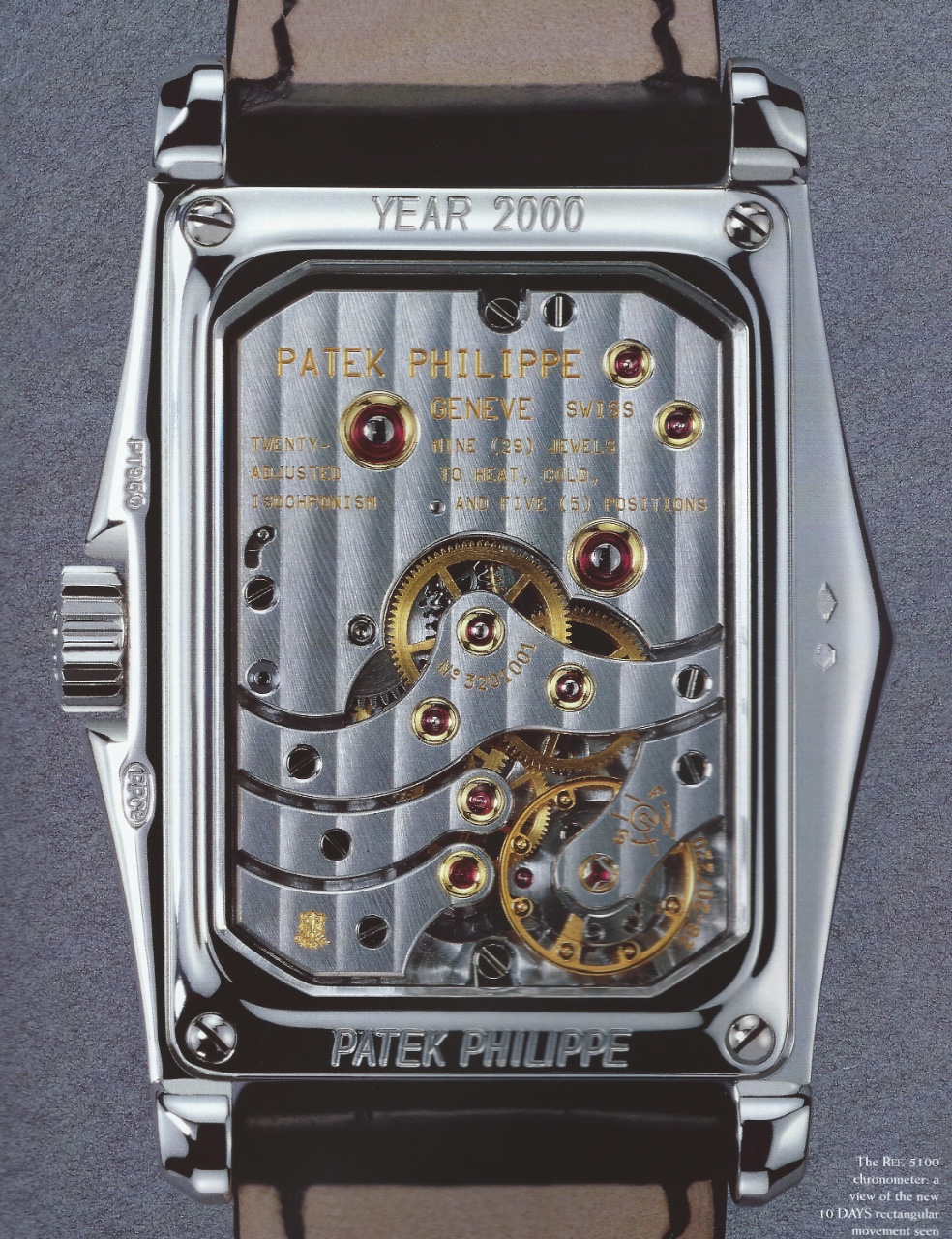
This movement took three years of research and development. The arrangement of bridges is simply sublime and remains unrivalled within the Patek Production.
This caliber has equipped just one reference but not the least aka the legendary “10 days” 5100 which was a limited edition celebrating the new millennium. Three thousand pieces were produced:
- 1500 pieces in yellow gold / white dial
- 750 pieces in rose gold / gray dial
- 450 in white gold / blue dial
- 300 pieces in platinum / black dial
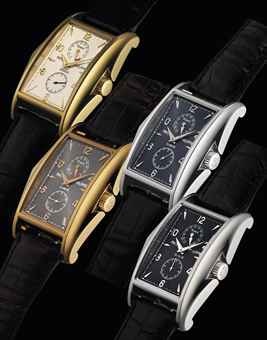
The casts and tools used to manufacture the cases were destroyed to ensure that this model could not be produced anymore.
The shape of the case is inspired by the so-called “Manta Ray” 2554 reference. However its dimensions are more substantial than the inspiring model. The 2554 reference measures 41.00 by 28.00 mm whereas the 5100 reference is larger by more than a half centimeter in both length and width with fairly generous dimensions of 46.10 by 34.20 mm and a thickness of 13.60 mm. The case is slightly curved in order to allow a proper positioning on the wrist.
The dial is simple but beautiful: two subsidiary dials displaying the small second and the power reserve respectively ensure a perfect balance of the whole. Arabic numerals alternating with faceted index as well as Dauphine hands reinforce the harmony of the dial.
Launched in 2003, the caliber 28-20 REC PS 10 J MRI features a beautiful tourbillon while ensuring a power reserve of 10 days thanks to a twin barrel. Its dimensions are 28.00 by 20.00 mm for a thickness of 6.30 mm. Like its predecessor, this caliber has a Gyromax balance and beats at a frequency of 21,600 vibrations per hour. It takes about one hundred turns of the crown to fully wind the two barrels. It equips the reference 5101 “10 days” Tourbillon that is no longer available.
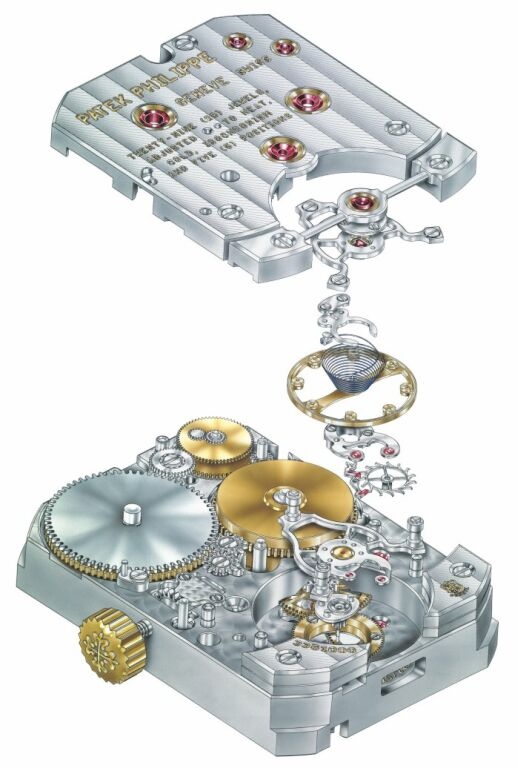
I had the opportunity to handle several times the 5101P reference. The quality of finish of the movement is stunning and in particular the tourbillon cage, which occupies almost half of the movement. Polishing the tourbillon cage requires more than week of work from a skilled craftsman.
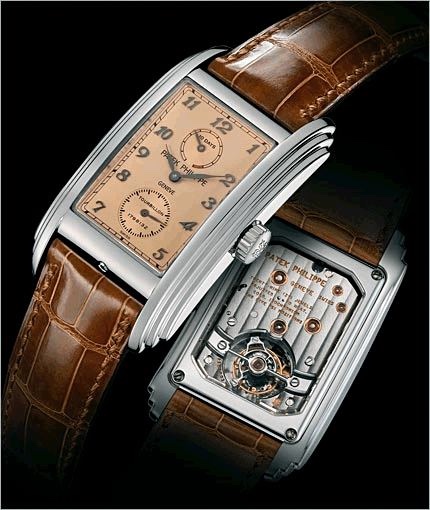
The 5101 case is of the same vein. To me, this is the most beautiful Art Deco style case ever produced by Patek Philippe. Its triple tiered flanks are just a work of art. The curved profile of the case ensures a good fit on the owner’s wrist. Similarly, the convex profile of the sapphire top glass extends the curvature of whole case. There is however a drawback. The dimensions of this watch are substantial: a length of 51.70 for a width of 29.60 mm make this watch not suitable for smaller wrists like mine. This watch was anyway out of my league.
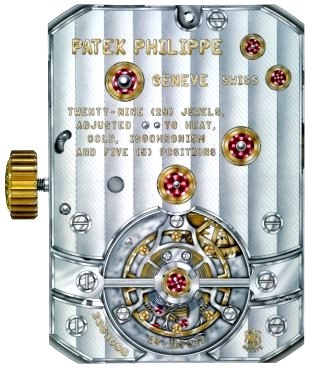
The dial is in the same spirit as 5100 with a well-balanced distribution between the auxiliary dials for the power reserve and the small second.
Like all tourbillons at Patek Philippe, it is not apparent. To admire it, you must turn the watch. I still don’t get why Patek Philippe is sticking to the “tradition” of having the mention “Tourbillon” and the movement reference number engraved on the dial. Such watch does need to show off its pedigree.
The 5100 reference was available in platinum, rose gold, white gold and yellow gold.
In 2013, Patek Philippe announced the release of the 28-20 REC 8J PS IRM C J caliber that equips the reference 5200 Gondola, 8 days with day and date indication. This caliber has the exact same dimensions as of its eldest brother: 28.00 by 20.00 mm with a thickness of 5.05 mm. It features a twin barrel. Compared to its two predecessor, the frequency of the movement has increased to 28,800 vibrations per hour (4 Hz). The power reserve is nevertheless brought back to eight days as this caliber features a day and date indication with instant jump. Such complication requires more energy for passing to the next day. Fully winding this caliber requires 134 turns of the crown.
This caliber also includes innovations that have been developed for "Advanced Research" models. The movement is fitted with a Spiromax® balance spring and a Pulsomax® escapement. This escapement with a Silinvar® (silicon based material) lever and escape wheel requires no lubrication while operating virtually without friction. It also features a very useful stop second function.
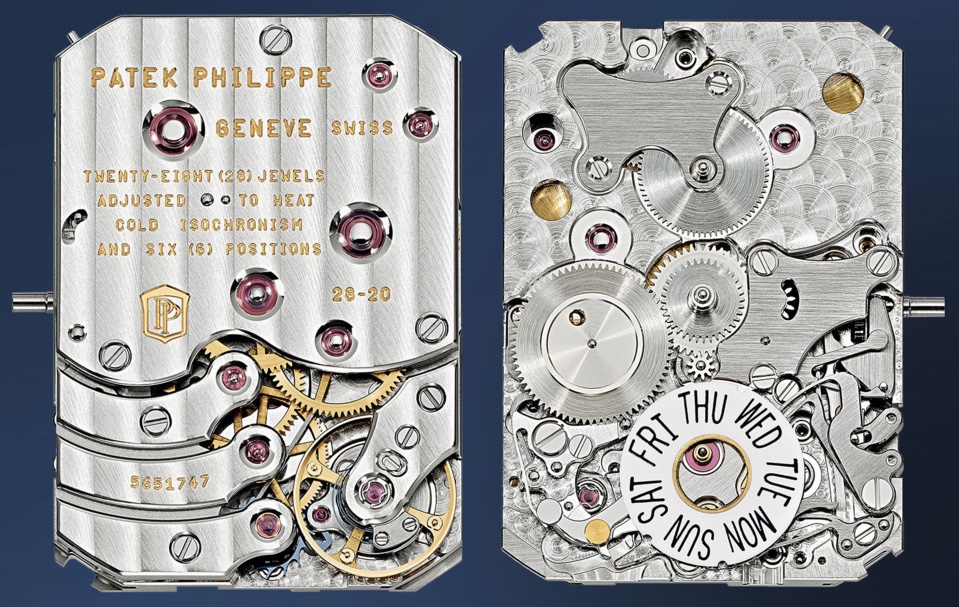
Some may regret that the going train bridge gives the illusion of three separate bridges. Patek Philippe does not hide that fact. It does not bother me although I would have preferred three separate bridges. In this respect, this caliber is less elegant than its older siblings.
The rectangular case has a fairly generous size: 46.90 by 32.40 mm and a thickness of 11.63 mm. The two-tiered mirror polished flanks give the watch a very distinctive Art Deco style look but slightly understated compared to its two prestigious predecessors. The white gold case has an anatomical arched profile providing an optimal wearing comfort. The screwed case back incorporates an anatomically contoured sapphire-crystal insert whilst the crystal protecting the dial is ground to a convex shape that follows the silhouette of the case. The dial is in the same spirit as 5100 with a well-balanced distribution between the auxiliary dials for the power reserve and the small second. The dial is available in blue sunburst or silvery white. I have a clear preference for the blue dial.
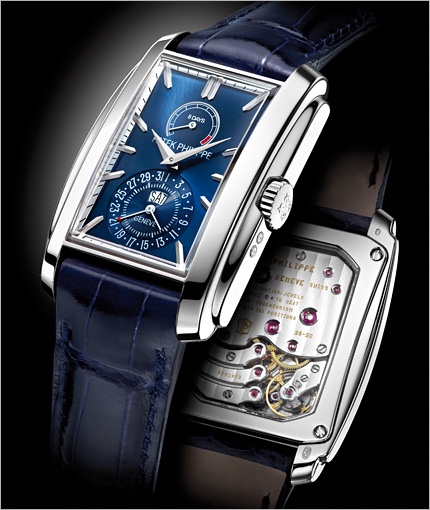
The subdial of the eight-day power reserve is placed in the upper half while the lower half is reserved for the calendar function featuring a 31-day scale for the date and an aperture for the day of the week. The second’s subdial is integrated in to day date circle. A red arrow finishes the small second hand. The faceted white-gold hour markers are mirror-polished for the blue dial and blackened for the silvery opaline dial. The dauphine hour and minutes hands reinforce the Art Deco character of the watch.
While the 5200 was announced at Basel world in April 2013, Patek Philippe had to spend more than one additional year to ensure the full reliability of the new caliber. The first references appeared on the market towards the end of 2014.
I had the opportunity to try both “prototype” versions during an event organized by my Patek Philippe retailer in the fall of 2013. The blue dial version was just mesmerizing. A few weeks later, as I was taking delivery of my long awaited 5131G, I placed an order for a 5200G with a blue dial.
During his presentation in April 2013, Thierry Stern announced that the production of 5200 would be rather limited.
If the watch is readily available at the Patek Philippe Salons, my faithful dealer is allotted just one piece a year. As usual with Patek Philippe, patience is a necessary virtue. In 2015, my dealer received the first piece that was allotted to him but it was the white dial version. A blue dial 5200 finally landed in March 2016.
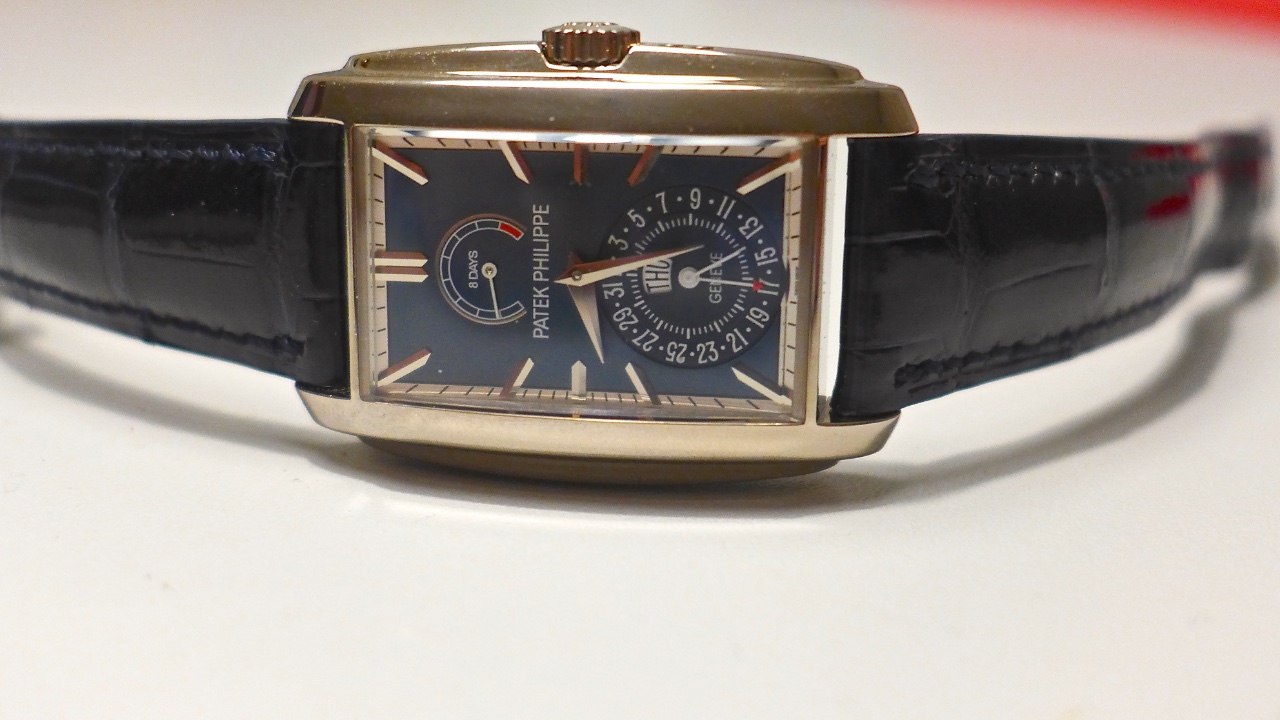
After almost three two years of waiting, I finally get to wear my first shaped watch. It meets all my expectations: a beautiful rectangular movement with interesting complications, a classic and elegant style with a touch of fantasy. Thanks to its blue sunburst dial, this watch is as dressy as casual and is therefore the perfect watch for the weekends when I don’t want to wear my Nautilus or my vintage Submariner.
This watch complements well my small collection:
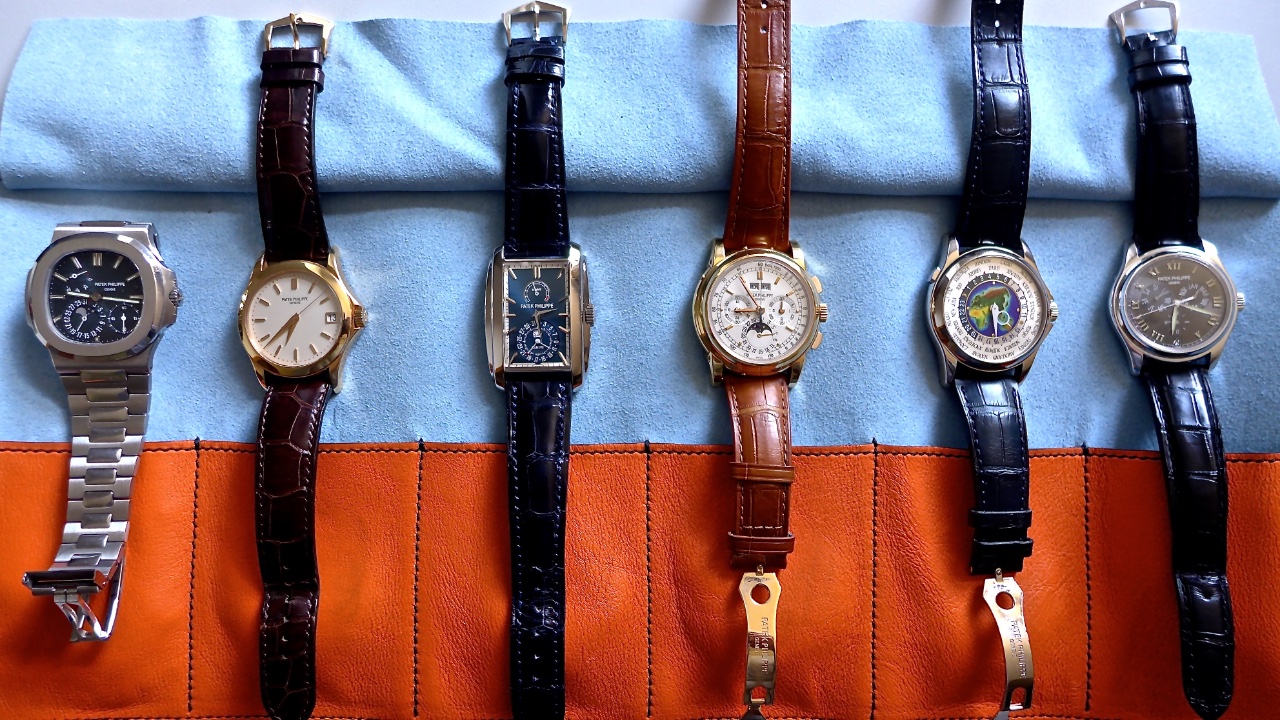
Sources:
- Patek Philippe Magazine
- Complete Catalogue of the Patek Philippe Museum - Patek Philippe Volumes I & II, Patek Philippe 2013
- J. Goldberger, Patek Philippe Steel Watches, Damiani Editions as well as the link to the steel watches database:
url=http://www.johngoldbergerwatches.com/References.html]
www.johngoldbergerwatches.com .html[/url]
- M. & A. Huber Banbery, Patek Philippe Geneva, Volume 2 Wristwatches, Second Edition, Patek Philippe
- Michael J. Mehltretter, Patek Philippe - Cult Object and Investment, Schiffer, 2012
- O. Patrizzi Collecting Patek Philippe Wristwatches, 2 Volumes, First Edition, Guido Mondani 2004
- J. Reardon, Patek Philippe in America - Reference Guide, Vomume 1 Men's Watches, Cefari 2010
_______________________________
This message has been edited by Mark in Paris on 2016-04-10 05:55:44









Next Article
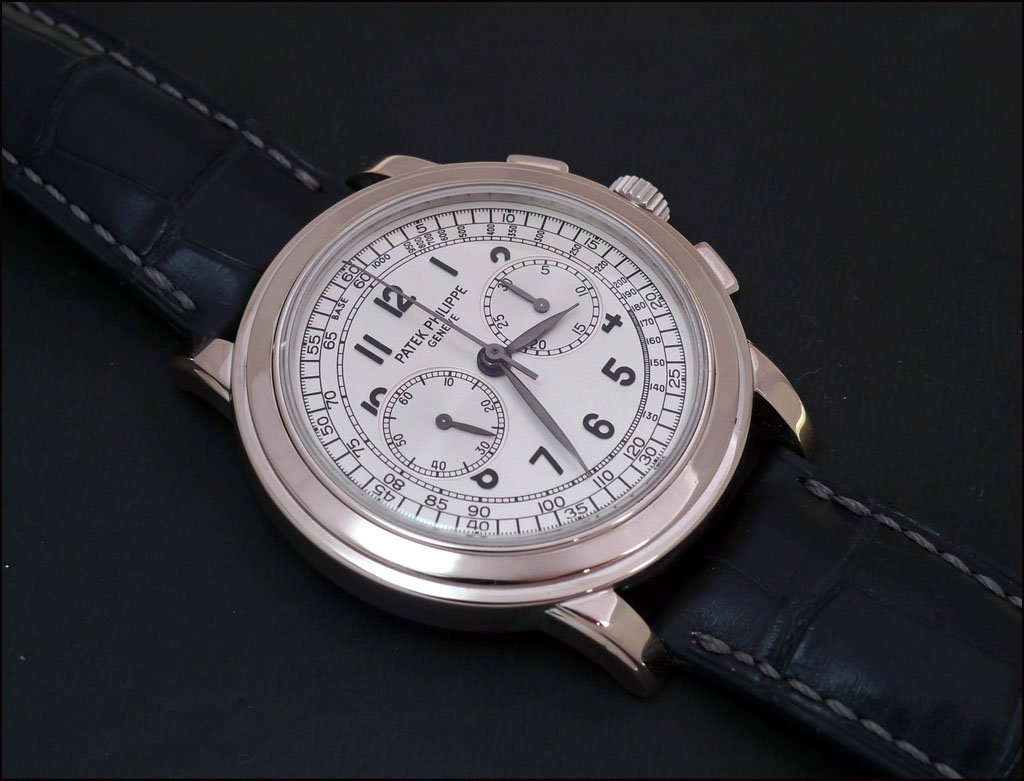

Patek Philippe 5070 : An In Depth Review.

© 2017 - WatchProZine